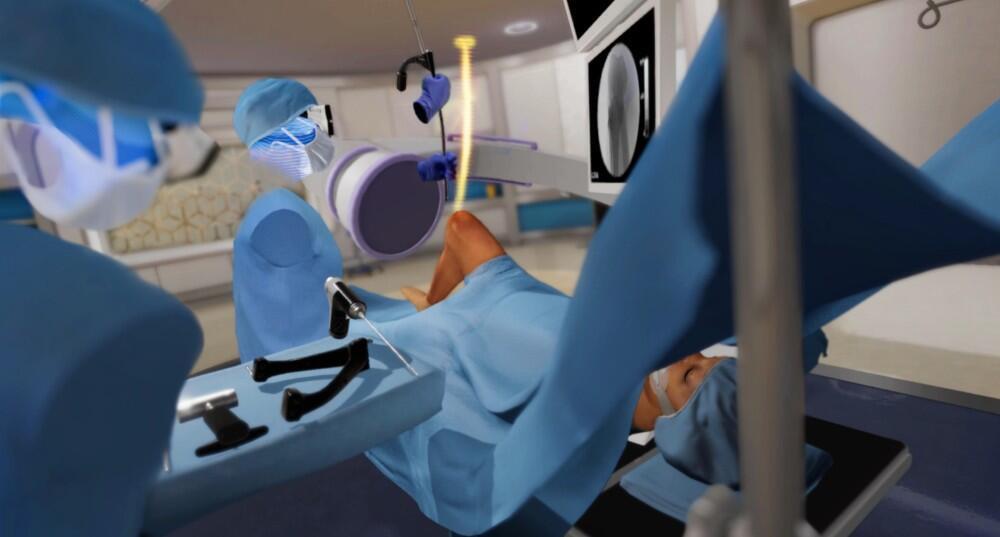Gamer-turned-doctor created a company that helps physicians become better at their jobs, especially during a pandemic.
TechRepublic’s Karen Roby spoke with Dr. Justin Barad, surgeon, CEO and co-founder of Osso VR, about using virtual reality to train surgeons. The following is an edited transcript of their conversation.
Karen Roby: Tell us about how VR is helping when it comes to training physicians and then we’ll get into how you got into this.
Justin Barad: We really try and lead by problem, at Osso VR, we practice something called need-based innovation. I think describing how training works in healthcare today can help explain what we’re trying to do at Osso. The problem that we’re facing when it comes to training healthcare professionals, and this is anything really from putting in an IV to doing complex robotic surgery, are really four dynamics currently. The first is, there is simply too much to learn, so in a way we’re victims of our own success.
SEE: TechRepublic Premium editorial calendar: IT policies, checklists, toolkits, and research for download (TechRepublic Premium)
If you think about it, scientific and technological progress are constantly expanding the library of procedures healthcare professionals are just expected to know how to do on demand. I always tell this story, this is a very extreme example, but I was one day just eating lunch minding my own business when I was paged urgently to the zoo to operate on a gorilla that had been pushed off a cliff, we’re driving down to the zoo, I didn’t know I was expected to be able to operate on gorillas, there’s a lot of Googling going on and that went great. That’s a whole other probably interview for another time.
What that highlighted for me is that every day in healthcare, we’re dealing with a gorilla-like situation, either a surgery we’ve never done before, a type of pathology or anatomy that we’re unfamiliar with or haven’t seen in a while. That was a really eye-opening moment for me. The second part of the problem is that modern procedures, modern surgery is a lot more complicated than those of the past, so learning curves are getting a lot longer, in some cases, 10 times longer. A recent study showed that to become proficient in a modern, minimally invasive procedure for something like maybe hip replacement, you have to do the surgery 50 to a 100 times to do it proficiently. And that wasn’t people in training, that was a fully trained specialized joint surgeon, still needed to do it 50 to 100 times, yet the way that we train is still the same. It’s a century old.
The third part of the problem, and this is often very shocking to people outside of healthcare, is that there is almost no assessment of technical skills whatsoever at any point. To give you an example, in my career as a surgeon and I can’t wait to tell you the story of how this all came to be, but the only time I’ve really been objectively assessed for my technical ability, I was asked to play the board game operation and remove the funny bone piece without buzzing, which I did and I’m very proud of.
SEE: 5 Internet of Things (IoT) innovations (free PDF) (TechRepublic)
Karen Roby: I’m impressed!
Justin Barad: Thank you. Hello. How are you? So that shows you where we are right now in terms of our ability to assess. And oftentimes our insight into issues with technical proficiency are after harm has been done to a patient, and an extreme example is the podcast “Dr. Death.” It’s very entertaining, very interesting story. Obviously, most surgeons and most healthcare professionals are very safe, but it could just highlight how that lack of insight before harm is done is very important. And then finally, there’s COVID-19 which we’re all too familiar with at this point, but the main way that we train especially once we’re done with our formal training, which is residency and fellowship, is at large-scale conferences and courses.
We learn new skills by getting together in groups of hundreds if not thousands of people and practicing, but we can’t do that at all right now, really, and it’s unclear in the future how much that will be available or how much people are even going to want to do something like that. So with all that being said, Osso VR offers the opportunity to train and assess yourself on any procedure in virtual reality in order to learn new procedures, keep yourself fresh on old procedures and learn some foundational procedures and especially things that are called low-frequency, high-urgency situations.
Something we pull from aviation, like if you’re flying a plane and an engine goes out, pilots are often able to land those planes because every six months they’re simulating those situations in case that ever happens, even though most likely most pilots will never experience that. The company, and I’ll get into the details, but we’re being used in 20 countries. We train thousands of surgeons a month, the team now we’re over 80 people. We have over a hundred different training modules in VR and have the world’s largest VR surgical training library. What we’re trying to do in the world is really improve patient outcomes with better education and assessment, increase the adoption of high-level medical technologies like robotics, and then democratize access to surgical education around the world.
Karen Roby: As a surgeon, yourself obviously you saw the need, did you have any experience when it comes to technology with VR? Or how did you even come about this is how we need to get this done?
Justin Barad: It was definitely a winding path, what was once a very chaotic career in a lot of different places now feels very meant to be. I originally started out life as an aspiring video game developer, so I’ve been programming since middle school. I have a game credit at Activision, a major video game publisher. What got me interested in healthcare was really, I had a family member who was quite ill and I just started wondering, and in a way becoming fixated on the idea of if there was a way to use software and technology, not necessarily for entertainment, but to help people. And so in college I ended up switching from computer science to biomedical engineering, with this idea that I would become an inventor of healthcare technology. But as I neared graduation from college, I didn’t really know how to get started with invention or innovation. I didn’t know where to begin.
SEE: AI in the OR: One company is closing the gaps in surgery using technology (TechRepublic)
So, I sought advice from a mentor of mine who told me something that just sticks with me to this day. And I try and think about this with every decision I make, which is, “If you want to invent something, you need to understand the problem you’re trying to solve first.” And he thought that the best way to understand medical problems was to be a doctor. So in retrospect, I may have taken his advice a little literally, so I ended up going to medical school at UCLA and then I stayed there to do my training in orthopedic surgery. And then I subsequently did a fellowship in pediatric orthopedics at Harvard and Boston Children’s Hospital, and then a medical Innovation Fellowship at Stanford. Basically, because of my background in gaming, I got involved in virtual reality very early.
With the earliest iteration of the Oculus Rift, which was called the Oculus DK1, I put it on my head, I’m in this demo in Tuscany, in Italy. It was very hard to get your hands involved back then, but I was able to do it with some things I bought off of eBay and hacks and so I’m in this Villa in Tuscany and I’m picking up some chairs and books, and these are the controllers that you use, and I look at it I’m like, “I can train surgeons with this, like 100%.” I had this background, so I built a prototype and I met a developer on the internet and I was like, “Hey, check this out.” He’s like, “Oh, I’m pretty interested.”
This is all a true story, I had some money saved for my bar mitzvah, so I use that to pay him to polish it up. And ultimately he became my co-founder Matt, and it started winning awards and getting a lot of interest. Suddenly we had investors and we’re like, “Let’s try and do this in earnest.” And I ended up basically dropping out of academic medicine to try and start this company, basically with a guy I met on the internet, we only met in person one time. It was a pretty interesting time in my life for sure, but I don’t regret it for a second.
Karen Roby: Do you see that people are starting to understand that VR when it comes to training on so many different technologies, could really be a great way to get things done in a safe environment.
Justin Barad: It’s a very exciting time right now with the adoption of this technology both in our field of technical training for procedural training in healthcare, but you see it across the board, both for VR in general, and also, especially when it comes to serious VR at enterprise training, is by far seems to be the killer app, and you’re seeing it. Every employee at Walmart uses VR to train now, plumbing training is becoming huge in VR at a company just raised a major round there. You’re just seeing a lot of interesting use cases with really highly specialized training platforms within virtual reality. But in terms of the adoption, this latest iteration, which is I have the Oculus Quest 2 here, this is a very mature technology, for a consumer this is a $300 device.
SEE: CES 2021: New device listens to heart, measures ECG remotely (TechRepublic)
It’s cheaper than your smartphone and you don’t need a computer or anything to use it, you have these controllers that track your hands, you put it on your head suddenly you’re instantly in an operating room or you’re instantly learning to fly a plane or how to swap out a toilet. It’s incredible. I mean, it’s like science fiction technology that anybody can afford. You’re really seeing a lot in the enterprise, but also in the consumer space, Oculus Quest 2 right now they’re almost 3 million people using these headsets simultaneously, and we’re seeing more and more, we have surgeons and nurses reaching out to us and be like, “Hey, I have a VR headset, can I just train on this at home?”
And so I think we’re really in the early stages of mass adoption of virtual reality which is a lot later than a lot of people had hoped it would happen, but it certainly seems to be happening right now. In our space of what we’re doing, we have thousands of these headsets now all around the world and surgeons training on a hundred different procedures. It’s really exciting for us that we really do feel like we’re just getting started, right, there are like hundreds of thousands of procedures that need to be simulated and 20 to 30 million healthcare professionals that are doing procedures with patients around the world, and we want to reach every single one of them. But the rate of growth that we’re seeing right now is completely unreal.
Karen Roby: I’m amazed just in the last year, obviously because of the pandemic, how many industries have had to embrace it with people being at home and they couldn’t be in each other’s space for training purposes. For healthcare specifically see this in the future, you’ve touched on orthopedics and obviously that’s your background, too. I mean, you obviously see that this will span through every specialty for physicians and nurses and other staff.
Justin Barad: We’re already seeing that, orthopedics is certainly where we got our start for a variety of reasons and obviously, like, my own personal bias. What we found is that the underlying technology that Osso VR has developed, which is pretty unique, which allows us to scale up the content creation of VR surgical training content, which is very hard to do. And so we’re like, “Would this work in other specialties?” And we found that the answer is yes. There’s almost no surgery that we can’t simulate in this platform with our methodology, which has been working really well. Especially areas like interventional procedures, like interventional cardiology, and interventional radiology and things like that. It’s really well suited for these things right now. At the very beginning, most surgeons and people I spoke to, they’re like, “This is video game technology. This can’t be used as a serious tool to train surgeons.”
What we’re seeing pre-pandemic is that that was quickly going away and this is like, OK, this is like going to be a future standard, and there’s more and more interest and our growth is accelerating. When the pandemic hit, like you said, suddenly went from a need to have, but a very urgent need to have, where suddenly we couldn’t train our residents or fellows at all. Or now we’re like a year or two in the hole, in terms of their training debt. Or surgeons who want to learn about new technologies like robots or navigation, these other really complex systems patient-specific devices, they can’t learn about them, and they can’t use them effectively because they’re not going to be able to fly out to a course, or they’re not going to be able to have this 500-pound equipment shipped out to them so they could try it out.
SEE: How VR and mixed reality are becoming important in the future of work (TechRepublic)
How do these companies, how do they train people to use their technology so that patients can get the very best technology? What I see as the end state of what we’re trying to do with our mission is, when you get on a plane, you are not Googling your pilot or like various people of the aviation team and looking at their Yelp reviews and their health grade scores and things like that, because you know generally it’s going to be the same result every single time, but when you or a loved one is getting a procedure, you do do these things because we know there’s a lot of variability and there are a lot of things that go into that. But part of that is the proficiency of the team in the specific procedure that they’re doing.
We’re not the whole solution, but leveraging these emerging technologies like robotics, like what we’re doing at Osso in our assessment platform and some interesting augmented reality and telementoring technologies altogether, this will lead to a much more consistent delivery of procedural care for medicine, so that when you are getting a procedure you can have the peace of mind of knowing that if you’re going to go to like NYU or HSS or UCSF, or maybe a smaller community hospital that’s local to you, you’re probably going to have the exact same results, much like you’re flying a plane. That’s the end state we’re really shooting for.
Karen Roby: Yeah. Make people feel a lot more confident about what they’re about to do I would certainly think. Well, I would think too for you, that has to be so rewarding, Justin, to have such a strong interest and background in medicine, but you understand and you know the tech and obviously love technology, so to be able to help, hopefully prevent mistakes and possibly save lives, I would think that that has to be a pretty cool place to be in.
Justin Barad: Yeah. I mean, as a physician, it’s thrilling to me to potentially have such a major impact with once again, what is considered video game technology. That’s what’s so crazy to me. We have research at Osso that’s been performed at UCLA or University of Chicago that shows that when people train on this technology, their performance goes up by 230% to 300%, which is like really crazy when you think about it, because you can change the types of devices or instruments you’re using and spend tens of millions of dollars and all these years researching it. The impact that you’re going to have is in like the 0.1, right?
SEE: US parents now more accepting of robots in children’s healthcare, study shows (TechRepublic)
In terms of the output. We’re basically making an interactive video game in VR in a sense, and you’re having double or three times the outcome, which is so amazing to me. So this technology is really exciting because we can get it to everyone instantly over the cloud and potentially improve the performance of surgical teams all around the world by 200%, 300%, like instantaneously. Yeah, as a surgeon, that’s just completely thrilling to me. And the other thing I’ll say that’s been really exciting about this personally for me is the team that I get to work with, the kinds of people that have been attracted to what we’re doing at Osso VR come from all walks of life. So we’re hiring people from the movie industry, from Industrial Light & Magic, from tech. People are coming from Apple, and Google, and Pinterest, and Microsoft, from video games. We have people coming from Nintendo and electronic arts. And from medicine, people coming from Medtronic and Smith & Nephew and other leading institutions.
And it’s like, the very best from all these different fields are coming together because everyone can relate with the problem we’re trying to solve, who hasn’t had a procedure? Know someone had a procedure? And had that anxiety and that fear, and it’s like, we can just make everyone better. And also give peace of mind to our healthcare providers as well knowing that they’re doing the very best job that they possibly can. So, the excitement and the energy right now that this team we’ve put together, I can’t emphasize enough, it’s like I am very humbled to work alongside these people. I have major impostor syndrome, but I’m learning so much from them. And it’s so exciting to see this movement developing, of trying to make a positive impact in the world.
Also see
” data-credit=”Image: Osso VR”>
The view inside a virtual reality training surgery on a leg. TechRepublic’s Karen Roby spoke with Dr. Justin Barad, surgeon, CEO and co-founder of Osso VR, about using virtual reality to train surgeons.
Image: Osso VR
Source of Article





